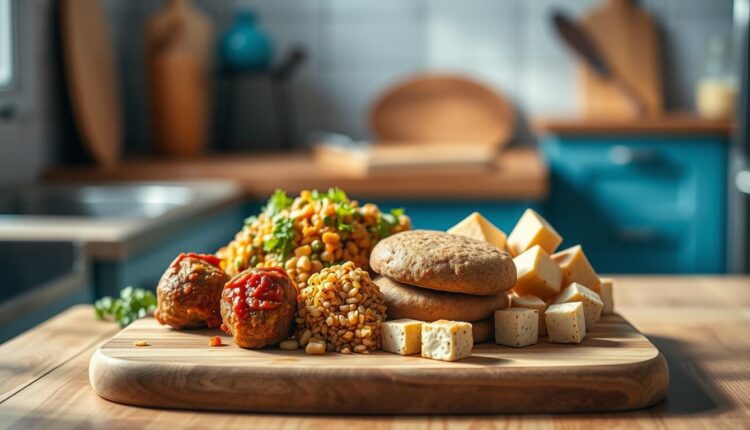Meal Prep For Work Protein Options Beyond Chicken Breast
Discover diverse meal prep for work protein options beyond chicken breast. Get practical tips and ideas for healthy, prep-ahead lunches that fuel your day. Simplify your meal planning
Raise your hand if your weekly food containers look like a chicken breast graveyard. (We’ve all been there.) But here’s the secret: building energizing, protein-rich lunches doesn’t require endless grilled poultry. As a chef juggling family dinners and recipe testing, I’ve discovered dozens of creative ways to keep midday meals exciting—without sacrificing nutrition or time.
This isn’t about rigid meal plans or Instagram-worthy bento boxes. It’s about practical variety—think smoky lentils, zesty shrimp bowls, or even a Greek-inspired salad packing 50 grams of. These strategies help busy folks like us stay fueled, curb cravings, and actually enjoy what we’re eating between meetings or carpools.
Key takeaways:
- Ditch the monotony with 10+ protein sources that cook faster than chicken
- Balance macros without complicated math or expensive ingredients
- Adapt recipes for dietary needs and freezer-friendly flexibility
Rethinking Protein for Meal Prep Success
Let’s start with a confession: My first attempts at prepping lunches looked like a science experiment gone wrong. Dry chicken strips, rubbery eggs, and enough steamed broccoli to feed a small army. Sound familiar? The turning point came when I realized variety—not perfection—is the key to staying consistent.
Planning ahead transforms chaotic mornings into grab-and-go ease. Batch-cooking three versatile proteins (like shredded turkey, marinated tofu, and chili-lime shrimp) lets you mix flavors all week. Studies show spreading protein intake across the day supports muscle repair better than cramming it into one meal. That’s why pre-portioned containers work so well—they align with your body’s natural recovery rhythm.
Here’s what I’ve learned through trial and error:
- Simple swaps (think smoked salmon instead of deli meat) keep taste buds engaged
- Marinating proteins while prepping veggies saves hours later
- Freezer-friendly staples prevent last-minute takeout traps
Your lunchbox should excite you, not feel like a chore. Whether you’re crushing deadlines or carpooling kids, smart prep turns nourishing eats into effortless wins. Ready to break free from the chicken-and-rice rut?
Why Diverse Proteins are Vital for Healthy Lunches
Your body thrives on variety, so why should your lunchbox be any different? I learned this the hard way after three straight weeks of turkey wraps left me reaching for vending machine snacks by 2 PM. Research shows rotating protein sources delivers a broader spectrum of amino acids – the building blocks your muscles crave.
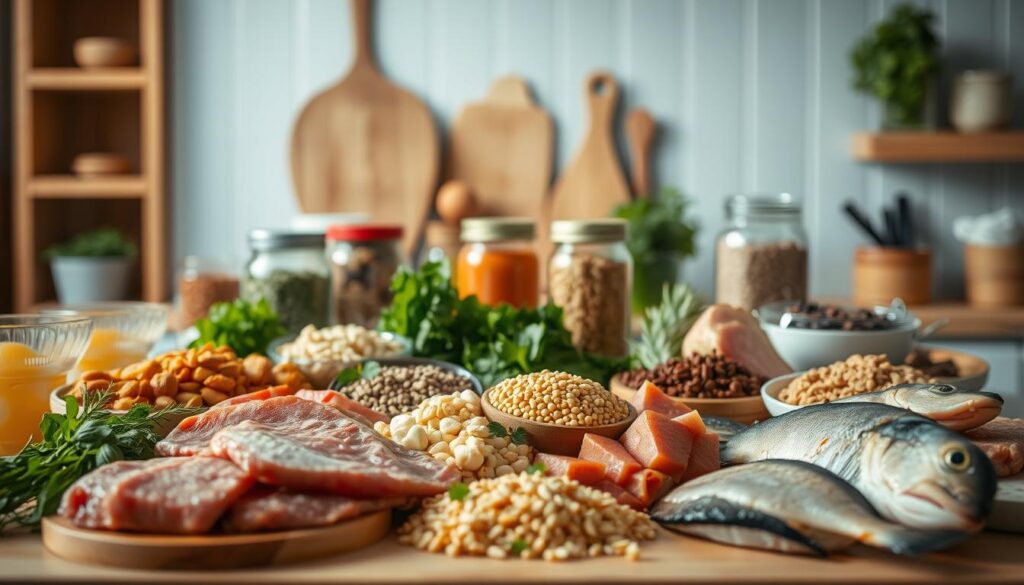
Fueling Muscle Building and Fat Loss
Animal proteins like salmon provide leucine to spark muscle growth, while plant-based options like black beans offer fiber to keep you full. A 2022 Journal of Nutrition study found people who ate mixed protein sources lost 15% more body fat than those sticking to one type. Here’s what works in my kitchen:
| Protein Source | Muscle-Boosting Nutrient | Prep Time |
|---|---|---|
| Lentils | 18g protein/cup | 25 mins |
| Greek Yogurt | 23g protein/cup | 0 mins |
| Chicken Thighs | 26g protein/serving | 30 mins |
Nutrient Timing and Portion Control Benefits
Pre-portioned containers aren’t just convenient – they’re science-backed. Eating 20-30g protein every 3-4 hours maximizes muscle repair. I pack smoked trout packets with cucumber slices for morning snacks, then enjoy chili-lime shrimp bowls at noon. Even a simple kale salad becomes powerful when topped with hemp seeds and hard-boiled eggs.
Last month, a client told me her energy “skyrocketed” after swapping daily deli meat for rotating proteins like marinated tempeh and curried chickpeas. Her secret? Sunday batch-cooking using my 1-2-3 method: 1 animal protein, 1 plant protein, 1 quick-cooking fish.
Meal Prep for Work Protein Options: Beyond Chicken Breast
Ever feel like your lunchbox is stuck on repeat? I once prepped grilled chicken salads for 12 straight days before realizing I’d rather face traffic than another dry bite. Variety isn’t just about taste—it’s your secret weapon against afternoon slumps and stalled fitness goals.
Breaking the Monotony of Traditional Proteins
While lean poultry has its place, relying solely on it limits both flavor and nutrition. Take seared tuna steaks—they deliver 40 grams protein per serving and cook faster than most chicken dishes. Or try smoky chickpea pasta loaded with 25 grams plant-based fuel. These bold swaps keep your midday meals exciting and your body guessing.
Here’s what I’ve seen work for busy professionals:
- Spicy shrimp stir-fry (ready in 15 minutes) outperforms basic chicken in both taste and omega-3 content
- Marinated tempeh cubes add crunch to grain bowls while boosting fiber intake
- Freezer-friendly lentil bolognese packs 22 grams protein per cup—no defrosting required
| Traditional Choice | Bold Alternative | Protein Boost |
|---|---|---|
| Grilled Chicken | Sesame-Ginger Tuna | +12g per serving |
| Turkey Wrap | Chickpea Flatbread | +8g fiber |
| Hard-Boiled Eggs | Miso-Glazed Salmon | +15g omega-3s |
Your turn: Next Sunday, swap one usual protein for something unexpected. Could be jerk-seasoned jackfruit or harissa-marinated cod. Progress happens when we trade routine for curiosity—one flavorful container at a time.
Exploring Plant-Based Protein Options
Who says plant-powered plates can’t satisfy like meat? During my years testing recipes, I’ve found vegan ingredients often surprise even skeptical carnivores. Take my lentil dal—simmered with turmeric and coconut milk, it delivers 22 grams of protein per bowl while tasting like comfort food.
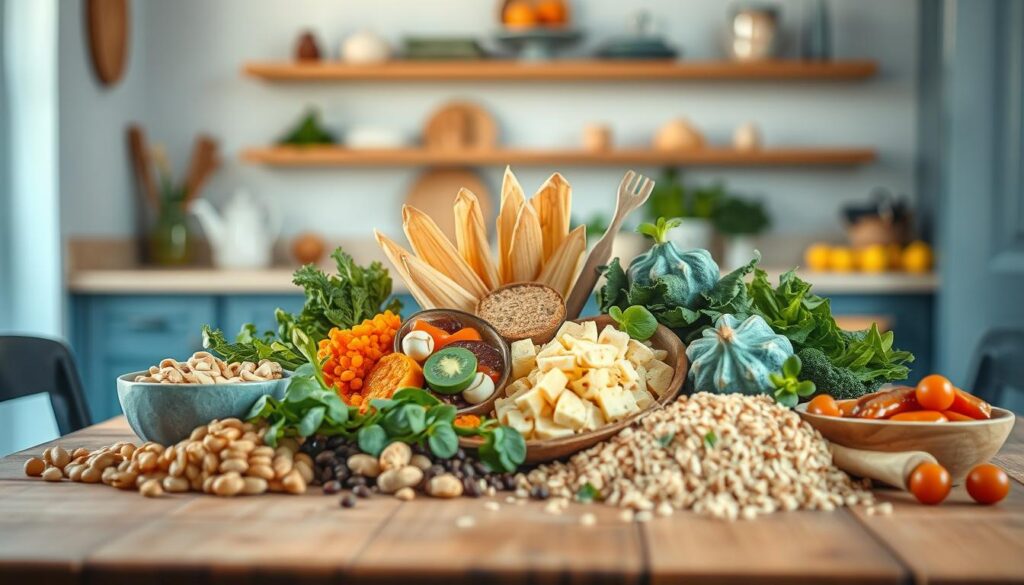
Tofu, Tempeh, and Legumes as Flavor Chameleons
Extra-firm tofu became my weeknight hero after discovering a trick: freeze it overnight before pressing. This creates a chewy texture perfect for absorbing marinades. Try cubing it with soy sauce and nutritional yeast—it crisps beautifully in 15 minutes. Tempeh shines when crumbled into chili or sliced thin for smoky “bacon” strips.
Beans? They’re the quiet workhorses. A batch of spiced black beans takes 20 minutes in the Instant Pot. Pair them with quinoa and roasted veggies for a complete amino acid profile. Pro tip: Add a splash of apple cider vinegar to legumes while cooking—it boosts iron absorption.
Why Plants Deserve a Spot in Your Rotation
Beyond ethics, plant-based foods offer unique perks. Studies show diets rich in tempeh and lentils support gut health through prebiotic fiber. My clients often report steadier energy levels after incorporating these options. Plus, they’re budget-friendly—a can of chickpeas costs less than most animal proteins.
Start simple: Swap half the ground beef in tacos for mashed kidney beans. Or blend silken tofu into creamy dressings. These small shifts build confidence without overhauling your entire menu. As one parent told me, “My kids didn’t even notice the lentils in their spaghetti sauce—they just asked for seconds.”
Seafood Sensations: Salmon, Tuna, and Shrimp Ideas
Ever opened your lunchbox to find the same sad sandwich staring back? Let’s fix that with oceanic flavors that dance on your tongue. During a chaotic week last month, I discovered how seafood can transform rushed lunches into moments of joy—without adding kitchen time.
High Omega-3 Punch with Salmon and Tuna
Wild-caught salmon isn’t just brain food—it’s a flavor powerhouse. My spicy salmon recipe combines chili flakes, lime zest, and maple syrup for a sweet-heat glaze. One 4-oz fillet delivers 27 grams of protein and enough omega-3s to support heart health. Pair it with roasted veggies, and you’ve got a lunch that fuels afternoon focus.
Prefer something bold? Try seared tuna steaks crusted with pink peppercorns. They cook in 90 seconds per side and pack 40 grams of protein per serving. Drizzle with a ginger-scallion sauce for tangy brightness. Pro tip: Buy sushi-grade tuna frozen—it thaws faster than chicken breasts.
Quick Shrimp Recipes for a Protein Boost
Shrimp are the unsung heroes of fast, nutrient-dense lunches. Garlic-lemon shrimp sauté in 5 minutes flat—toss them into zucchini noodles or whole-grain pasta. Need crunch? Bake coconut-crusted shrimp using shredded unsweetened flakes. Both options deliver 20+ grams of protein with zero meal prep drudgery.
Sauces make seafood shine. Blend avocado with Greek yogurt for a creamy dill dip, or whisk miso paste into honey for a glaze that caramelizes under the broiler. As one client raved, “The cilantro-lime sauce made my shrimp tacos taste like a beach vacation!”
Beef, Pork, and Other Meats for a Change
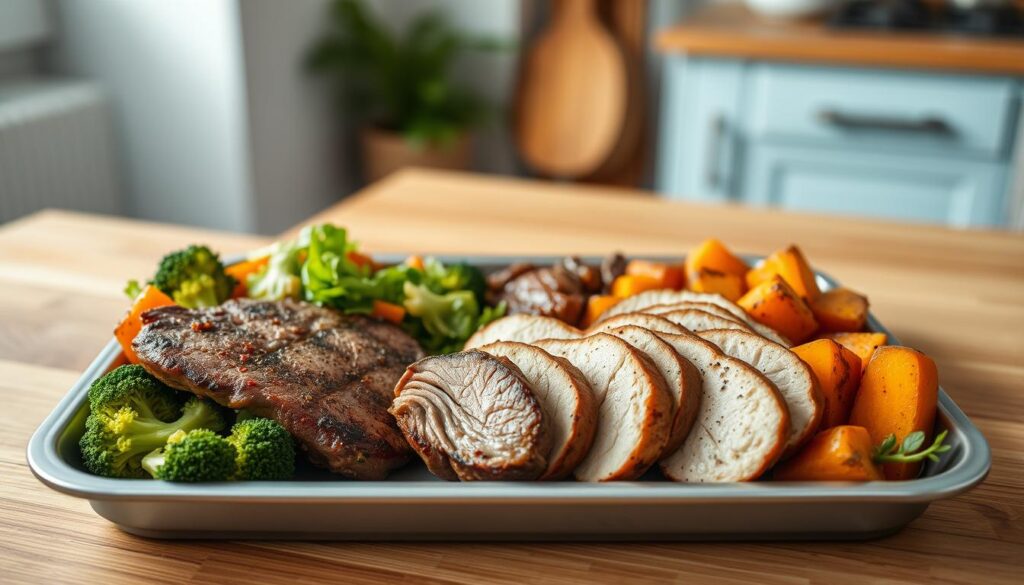
Remember that pork chop disaster I posted on Instagram last year? (Spoiler: It looked like charcoal.) But here’s the redemption arc—learning to work with diverse meats transformed my lunch game. Rotating proteins like grass-fed beef, applewood-smoked pork, and heritage-breed turkey keeps your taste buds guessing while delivering serious nutrition.
Lean Cuts and Flavorful Marinades
Not all meats are created equal. Opt for flank steak over ribeye—it’s leaner yet absorbs marinades like a sponge. Last week’s soy-ginger beef strips became taco fillings, salad toppers, and fried rice mix-ins. The secret? A 30-minute soak in citrus and spices tenderizes while infusing bold flavors.
| Meat | Lean Cut | Flavor Boost | Cook Time |
|---|---|---|---|
| Beef | Flank Steak | Soy-Ginger Marinade | 15 mins |
| Pork | Tenderloin | Apple Cider Mustard Glaze | 25 mins |
| Turkey | Breast Cutlets | Lemon-Herb Rub | 20 mins |
Marinating isn’t just for taste—acidic ingredients like vinegar or yogurt break down tough fibers. Try this hack: portion meats into zip-top bags with marinade before freezing. Thaw overnight, and they’re ready to sizzle by morning.
Even classic dinners get upgrades. Swap basic ground beef for bison in your next chili—it’s richer in omega-3s and pairs perfectly with smoky paprika. As one reader shared, “The coffee-rubbed pork tenderloin made me actually excited about Tuesday’s lunch!”
Eggs and Dairy Alternatives: Simple and Fast
Let’s talk about mornings when your coffee’s cold before you take a sip. Eggs saved my sanity during those chaotic weeks when even microwaving felt time-consuming. Their magic lies in transforming into grab-and-go fuel with minimal effort—no chef skills required.
Versatile Egg-Based Dishes for Meal Prep
My freezer always holds muffin tin frittatas—think spinach, sundried tomatoes, and crumbled feta. They reheat in 90 seconds and work as breakfast sandwiches or salad toppers. One Sunday batch yields 12 portions, each packing 14 grams of protein. Pro tip: Whisk eggs with cottage cheese for extra fluffiness without added fat.
“The egg muffin hack cut my morning scramble from 20 minutes to 20 seconds.”
| Egg Recipe | Prep Time | Protein Per Serving |
|---|---|---|
| Veggie Frittata | 25 mins | 18g |
| Breakfast Burritos | 15 mins | 22g |
| Shakshuka Jars | 20 mins | 16g |
Dairy swaps keep things interesting without heavy calories. Try nutritional yeast instead of Parmesan on roasted veggies, or blend silken tofu into quiche fillings. My kids devour scrambled eggs with shredded low-fat cheddar—half the usual cheese still gives that creamy texture they love.
Last month, a new client confessed she’d never cooked eggs beyond scrambling. We created her “egg mastery” plan: boiled eggs for salads, baked cups for snacks, and French toast casserole for weekends. Her text said it all: “I finally feel like a real cook!”
Cheese and Yogurt: Creative Dairy Innovations
Dairy isn’t just a sidekick—it’s the secret star of your lunchbox. I discovered this during a hectic week when crumbled feta turned my basic grain bowl into a Mediterranean escape. The right cheese or yogurt can add 15+ grams of protein while making leftovers taste fresh.
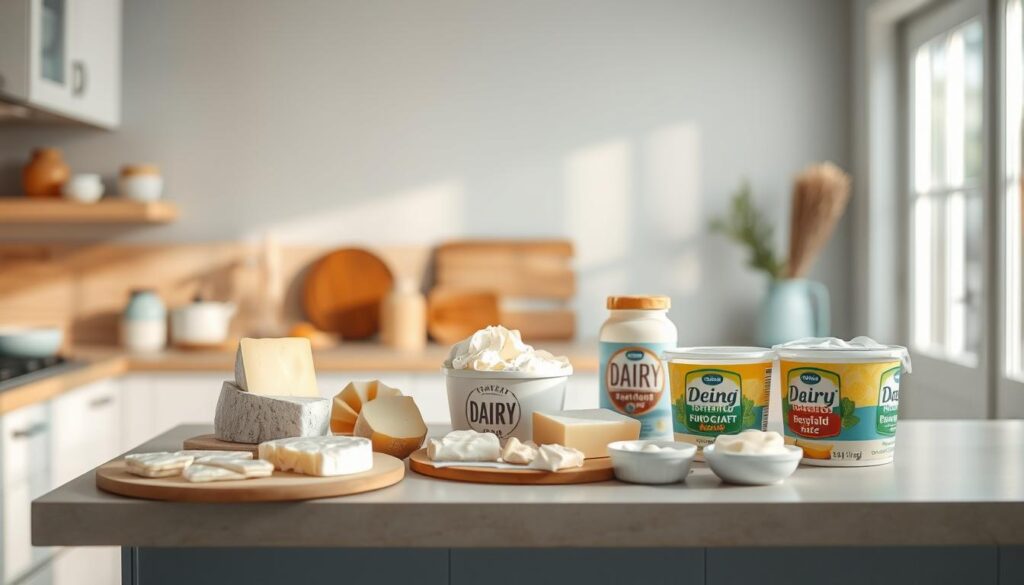
Sharp flavors work wonders. Aged cheddar elevates roasted veggies, while tangy Greek yogurt becomes a creamy base for dressings. Try blending it with fresh herbs and lemon for zesty coleslaw or drizzling over spicy chili. Texture matters too—crumbly queso fresco stays firm in salads, while melted halloumi adds chew to wraps.
| Cheese Type | Flavor Profile | Best Uses |
|---|---|---|
| Feta | Salty & Tangy | Grain Bowls, Egg Scrambles |
| Smoked Gouda | Rich & Earthy | Sandwiches, Soup Garnish |
| Ricotta | Mild & Creamy | Stuffed Peppers, Toast Spread |
Pairing tips from my kitchen:
- Swap mayo with yogurt in chicken salad for extra creaminess (and 8 more grams of protein)
- Layer cottage cheese with pineapple in overnight oats
- Use whipped feta dip as a veggie-packed sandwich spread
For balanced morning fuel, try these high-protein breakfast ideas. Remember: quality beats quantity. A little sharp Parmesan goes further than a bland handful. Your taste buds—and lunch routine—will thank you.
Grain Power: Rice, Quinoa, and Beans for Protein Completeness
Grains are the quiet champions of your lunchbox—they’re happy to let proteins shine but do the heavy lifting nutritionally. When paired strategically, these pantry staples create meals that sustain energy and satisfy cravings. My go-to move? Batch-cooking three grains each Sunday to mix with whatever proteins I’ve prepped.
Building Balanced Plates
Whole grains like brown rice and quinoa offer complex carbs for steady fuel, while beans add plant-based protein and fiber. Together, they form complete amino acid profiles—something I learned after a client asked, “Why am I starving by 3 PM?” Her solution? Adding ½ cup black beans to her usual chicken-and-rice bowl.
| Grain | Protein Per Cup | Perfect Pairing |
|---|---|---|
| Brown Rice | 5g | Lemon-Garlic Shrimp |
| Quinoa | 8g | Harissa Chickpeas |
| Black Beans | 15g | Chipotle Chicken |
Texture matters. For fluffy quinoa, rinse thoroughly and let steam off the heat. Sticky rice? Toss with rice vinegar to prevent clumping. Pro tip: Cook grains in broth instead of water—it adds depth without extra sodium.
Last week’s favorite combo: cilantro-lime quinoa with chili-roasted chickpeas. It held up in the fridge for four days and transformed into tacos, salads, and even a breakfast hash. As one reader shared, “The smoked paprika kidney beans made my usual turkey bowls taste brand new!”
Portion smart: ½ cup cooked grain + ¾ cup protein + 1 cup veggies. Freeze single servings in muffin tins for instant stir-fry bases. Your future self will thank you during chaotic afternoons.
Vibrant Veggie & Protein Bowls to Brighten Your Day
What if your lunch could be both fuel and confetti? That’s the magic of layered bowls—they turn routine eating into a confetti toss of colors, textures, and flavors. As a chef who’s packed thousands of lunch containers, I’ve found these adaptable dishes work like culinary mood boards. You get crunch from snap peas, creaminess from avocado, and zing from pickled onions—all in one bite.
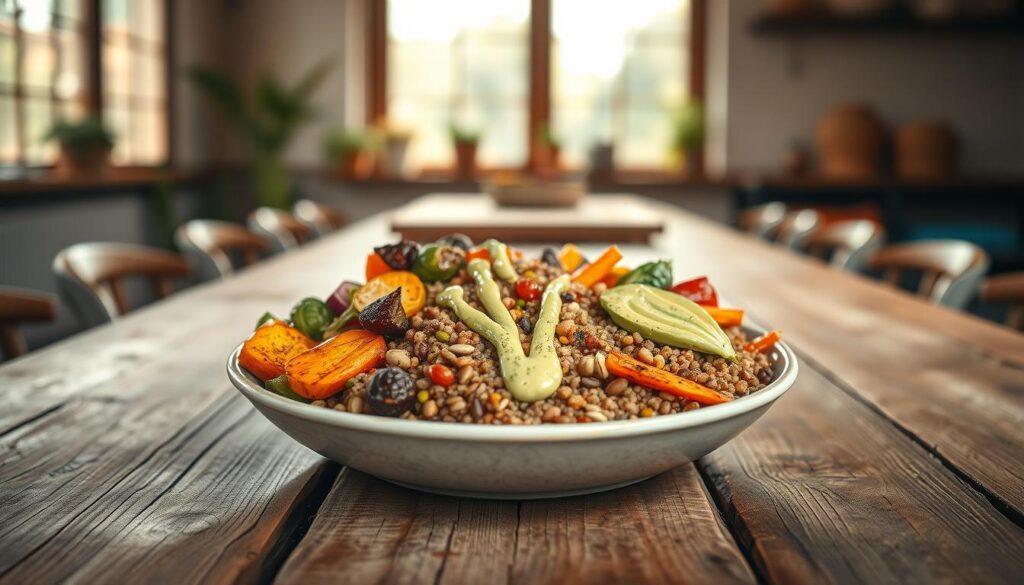
Mixing Fresh Veggies with Diverse Protein Sources
Start with a base: quinoa, brown rice, or massaged kale. Then layer roasted chickpeas, shredded chicken, or seared tuna. Add raw and cooked veggies for contrast—think spiralized beets and charred broccoli. My rule? Two textures minimum. Crumbled feta or toasted almonds add the final “crunch factor” that keeps each forkful exciting.
Last week, a client shared her breakthrough: “I used leftover salmon and rainbow slaw—it felt like eating out!” Her secret? Prepping components separately for mix-and-match freedom.
Bowl Inspirations for a Colorful, Nutritious Lunch
Try these combos that balance flavor and function:
- Mediterranean Power: Lemon-herb chicken, cucumber, hummus, and kalamata olives over farro
- Tex-Mex Fiesta: Spiced black beans, grilled corn, avocado, and lime-cilantro yogurt
- Asian Crunch: Sesame tofu, edamame, shredded carrots, and peanut-ginger drizzle
| Base | Protein | Toppings |
|---|---|---|
| Brown Rice | Chili-Lime Shrimp | Mango, Red Cabbage, Cashews |
| Quinoa | BBQ Tempeh | Roasted Sweet Potato, Pickled Onions |
| Spinach | Hard-Boiled Eggs | Cherry Tomatoes, Feta, Olive Tapenade |
Store components in Mason jars—dressing at the bottom, grains in the middle, greens on top. Flip into a bowl at work for instant freshness. As one teacher told me, “My students think I’m a gourmet chef now!”
Global Flavors: Asian, Mediterranean, and More
Ever stare at your lunch container and wish it teleported you somewhere exciting? That’s the power of global flavors—they turn routine into adventure without complicated prep. Last month, a jar of gochujang transformed my basic turkey wraps into Korean-inspired delights that had coworkers asking for the recipe.
Asian-Inspired Peanut Butter and Teriyaki Dishes
Peanut sauce isn’t just for noodles. Whisk it with lime juice and chili garlic for a dressing that jazzes up grain bowls. Try this hack: marinate baked tofu in teriyaki glaze while cooking quinoa. Layer with shredded carrots and edamame for crunch.
- 5-minute peanut dressing: ¼ cup PB2, 1 tbsp soy sauce, 1 tsp honey
- Sesame-crusted salmon over jasmine rice
- Miso-ginger slaw for tacos or wraps
Mediterranean Bowls and Wraps with a Twist
Sun-drenched flavors thrive in meal prep. Combine lemon-marinated chicken, quinoa tabbouleh, and roasted tomatoes for salads that taste like Santorini. My secret? Add avocado slices and spinach just before eating—they stay vibrant for days.
| Base | Protein | Flavor Boost |
|---|---|---|
| Whole Wheat Pita | Grilled Shrimp | Tzatziki + Dill |
| Farro | Chickpeas | Lemon-Tahini Dressing |
| Mixed Greens | Feta + Walnuts | Balsamic Glaze |
One client swapped her usual ranch for Greek yogurt dressing spiked with oregano. Her review? “My desk lunches now feel like a seaside café!” Start small—swap one ingredient weekly to build your flavor passport.
Quick & Easy Meal Prep Hacks for Busy Professionals
Ever spent more time staring into your fridge than actually eating? I’ve been there—until I cracked the code on kitchen efficiency. The secret? Treating meal prep like a well-choreographed dance, not a chaotic scramble. Let’s transform those Sunday afternoons into streamlined sessions that fuel your week.
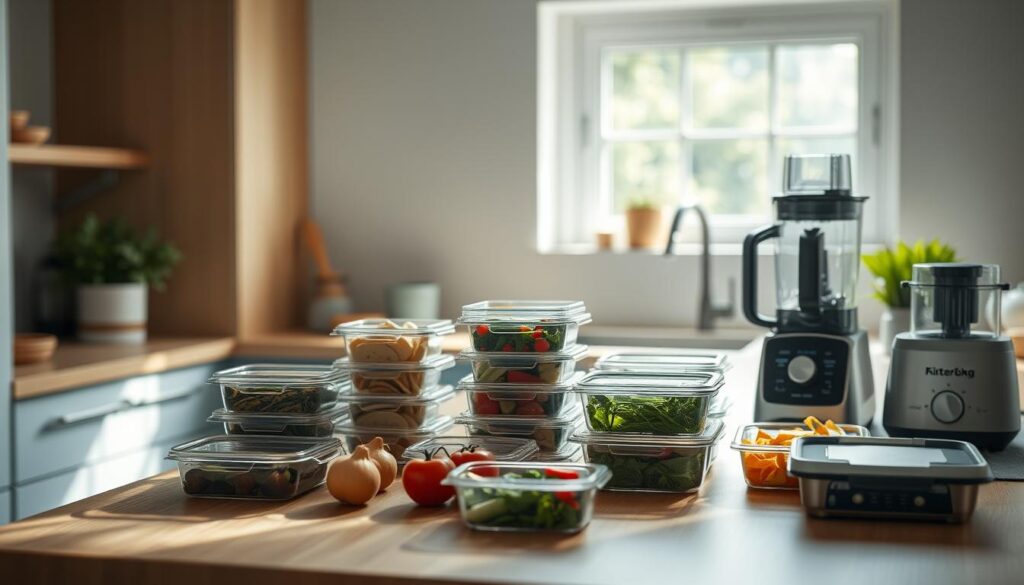
Time-Saving Techniques and Simple Recipes
Batch-cooking isn’t about endless hours—it’s smart strategy. Roast three sheet pans of veggies while your Instant Pot cooks quinoa. Portion everything into glass containers with dividers for grab-and-go ease. Last week’s “prep once, eat thrice” win: lemon-herb chicken thighs doubled as wraps, salads, and fried rice mix-ins.
Try these game-changers:
- Freeze smoothie ingredients in jars—just add liquid and blend
- Use muffin tins for individual frittatas or energy bites
- Marinate proteins in zip-top bags while prepping sides
| Task | Traditional Approach | Time-Saving Hack |
|---|---|---|
| Chopping Veggies | 15 mins daily | 1 weekly batch (45 mins) |
| Cooking Grains | 30 mins/stovetop | Instant Pot (12 mins) |
| Portioning Snacks | As needed | Sunday assembly line (20 mins) |
A client recently shared her breakthrough: “Prepping mason jar salads while my coffee brews changed my whole week.” Her trick? Layering dressing at the bottom, then grains, proteins, and greens. Flip and shake at work—no soggy spinach.
Remember: Efficiency isn’t about perfection. Even 30 minutes of strategic prep creates ripple effects. More time for morning workouts? Yes. Fewer 4 PM snack attacks? Absolutely. Your future self will high-five you.
Time-Saving Techniques and Container Solutions for Fresh Meals
Your containers are the unsung heroes of nourishing midday fuel. After years of testing every lunchbox style imaginable, I’ve found that strategic storage transforms rushed mornings into grab-and-go victories. The right system keeps flavors vibrant and portions balanced—even on hectic days.
Optimal Storage and Pre-portioning Tips
Invest in leak-proof containers with compartments—they prevent salsa from turning your grains soggy. Glass options withstand reheating, while BPA-free plastics stack neatly. Pro tip: Label lids with cooking dates using dry-erase markers.
| Container Type | Best For | Fridge Lifespan |
|---|---|---|
| 3-Compartment Glass | Complete meals | 4 days |
| Slim Stackable Bins | Pre-cut veggies | 6 days |
| Portion-Control Bowls | Proteins + sides | 5 days |
Pre-portion proteins first—weigh cooked chicken or tofu to hit 25-30 grams per serving. Store dressings separately in mini jars. This approach helped a client track macros without daily math: “Knowing each container has 28 grams lets me focus on flavor combos.”
Maximize vertical space with tiered organizers. Keep frequently used items at eye level—herb-packed yogurt dips, hard-boiled eggs, marinated beans. Rotate older containers forward to prevent forgotten leftovers.
Common challenges solved:
- Soggy greens: Line salad containers with paper towels
- Freezer burn: Vacuum-seal fish portions before freezing
- Spice separation: Shake dressings weekly
One Sunday investment in proper storage cuts daily prep time by half. As a busy parent recently shared: “The divided trays help my kids build balanced plates themselves—no more dinner-time negotiations!”
Smart Shopping and Ingredient Prep Tips
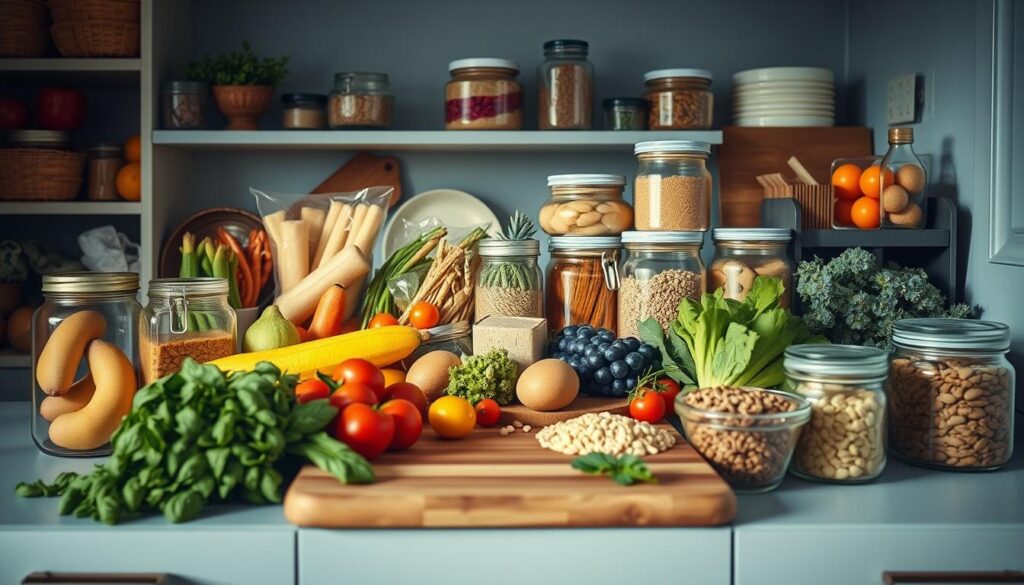
How many times have you stood in the grocery aisle wondering if you forgot the avocado… again? I’ve learned the hard way that strategic shopping turns chaotic trips into streamlined victories. Start with a categorized list—proteins in one column, veggies in another, pantry staples last. This prevents backtracking and impulse buys.
Pre-washed greens and pre-cut veggies are worth the splurge when time’s tight. Portion proteins into zip-top bags with marinades before freezing. A client once shared her “fridge zones” system: cooked items on top, raw meats below, ready-to-grab snacks front and center.
| Ingredient | Prep Method | Fridge Life |
|---|---|---|
| Spinach | Washed + paper towel layer | 5 days |
| Chicken Breast | Shredded + portioned | 4 days |
| Bell Peppers | Sliced + airtight container | 6 days |
Versatile stars like avocado bridge sandwich spreads and salad toppings. Mash one with lemon juice for wraps, or slice it over grain bowls. Pair with a morning routine that sets up your day.
Budget-friendly hacks:
- Buy frozen shrimp—thaws faster than fresh
- Use mason jars for bulk-bin grains and nuts
- Repurpose herb stems into pesto or broth
Label everything. A dry-erase marker on containers saves “is this still good?” debates. One reader transformed her kitchen by dedicating Sunday afternoons to washing produce and roasting two sheet pans of veggies. Her secret? “I treat my fridge like a puzzle—every ingredient has its place.”
Creative Leftover Transformations for Protein Packed Meals
Leftovers often get a bad rap, but they’re actually your kitchen’s secret weapon. Last Tuesday’s herb-roasted chicken can become today’s zesty Greek salad—no reheating required. The key? Treating extra ingredients as building blocks rather than boring repeats.
Try this weeknight recipe hack: Shred leftover poultry into burrito bowls with black beans and lime crema. Top with pickled onions for crunch. One client turned chili into stuffed peppers, boosting each serving to 22 grams protein while cutting food waste. Her review? “My family thought it was a brand-new dish!”
| Leftover Ingredient | New Creation | Protein Boost |
|---|---|---|
| Grilled Salmon | Quinoa Power Salad | 25 grams |
| Brown Rice | Fried Rice + Edamame | 18 grams |
| Shredded Pork | BBQ Slaw Wraps | 27 grams |
Always recalculate protein when repurposing. Mix ½ cup lentils into taco meat for extra fiber. A 5-minute recipe refresh: Toss roasted veggies with chickpeas and feta for instant grain bowls.
Embrace the dinner dilemma as a creativity challenge. As one reader shared: “Transforming last night’s curry into stuffed sweet potatoes felt like culinary magic—with zero extra cooking.”
Let’s face it—eating the same grilled chicken every day could make even a food lover yawn. But as we’ve explored, building energizing lunches isn’t about rigid rules or bland repeats. It’s about celebrating flavor diversity while fueling your muscle recovery and afternoon focus.
From smoky turkey wraps to zesty sesame-crusted tuna, these ideas prove nutrition doesn’t have to sacrifice taste. Batch-cook three proteins weekly, pair them with vibrant grains, and watch your lunchbox transform. Need breakfast inspiration? Try these morning meal strategies to start your day strong.
Remember: Small swaps create big wins. A lemon-herb marinade revives leftover salad toppings. Freezer-friendly eggs become instant protein boosts. Even that jar of chickpeas? It’s 15 grams of plant power waiting to shine.
Your turn: Pick one global recipe this week—maybe harissa shrimp or curried lentils. Prep it Sunday, enjoy it Tuesday, and savor the confidence that comes with nourishing variety. Because when lunch excites you, conquering your day feels effortless.
Spicy Miso Tempeh and Edamame Rice Bowls
A flavorful and protein-packed vegan bowl featuring marinated tempeh, edamame, and brown rice, all brought together with a spicy miso glaze.
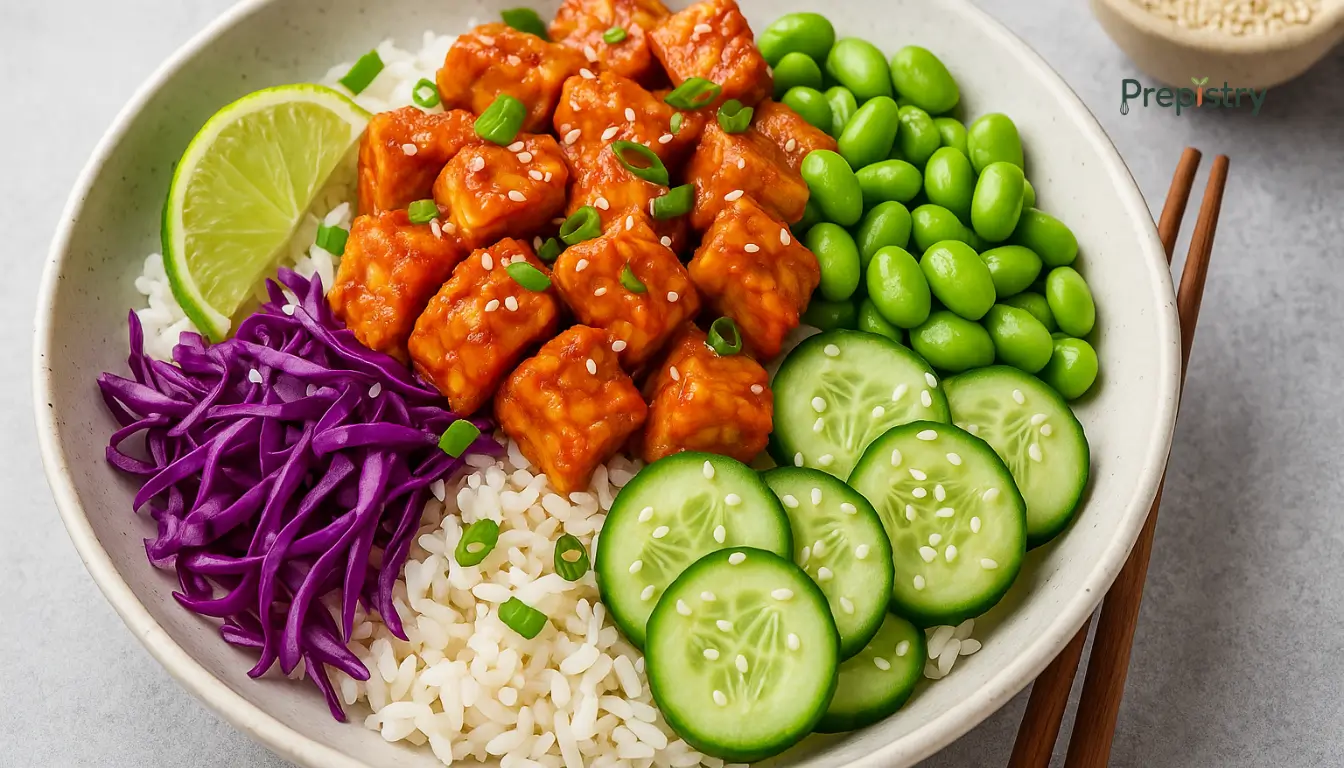
Nutrition Information
Equipment Needed
- Large skillet
- Medium saucepan
- Mixing bowls
- Cutting board
- Knife
Ingredients
-
1 cup brown rice
-
200g tempeh, sliced into cubes
-
1 cup shelled edamame
-
2 tablespoons miso paste
-
1 tablespoon soy sauce
-
1 tablespoon maple syrup
-
1 teaspoon sesame oil
-
1 teaspoon sriracha
-
2 cloves garlic, minced
-
1 teaspoon fresh ginger, grated
-
2 green onions, sliced
-
1 tablespoon sesame seeds
-
1 tablespoon vegetable oil
Instructions
Recipe Video
Spicy Miso Tempeh and Edamame Rice Bowls
Learn how to make these delicious Spicy Miso Tempeh and Edamame Rice Bowls, a perfect vegan meal packed with flavor and protein.

